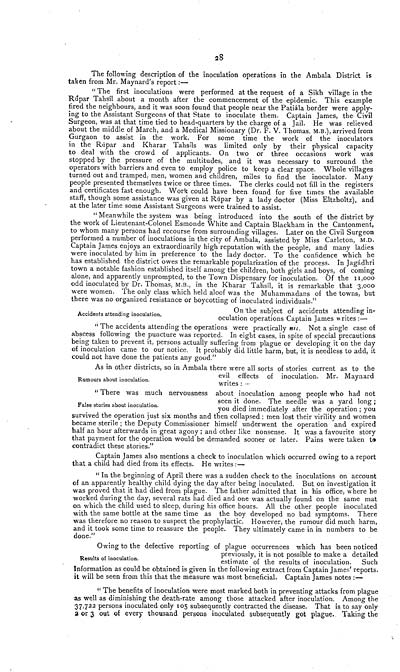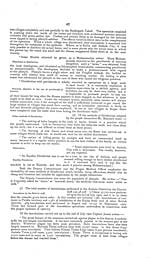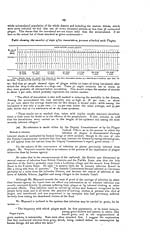Medicine - Disease > Report on plague in the Punjab from October 1st ... to September 30th ..., being the ... season of plague in the province
(42) Page 28
Download files
Individual page:
Thumbnail gallery: Grid view | List view

28
The following description of the inoculation operations in the Ambala District is
taken from Mr. Maynard's report :-
" The first inoculations were performed at the request of a Sikh village in the
Rpar Tahsl about a month after the commencement of the epidemic. This example
fired the neighbours, and it was soon found that people near the Patila border were apply-
ing to the Assistant Surgeons of that State to inoculate them. Captain James, the Civil
Surgeon, was at that time tied to head-quarters by the charge of a Jail. He was relieved
about the middle of March, and a Medical Missionary (Dr. F. V. Thomas, M.B.), arrived from
Gurgaon to assist in the work. For some time the work of the inoculators
in the Rpar and Kharar Tahsls was limited only by their physical capacity
to deal with the crowd of applicants. On two or three occasions work was
stopped by the pressure of the multitudes, and it was necessary to surround the
operators with barriers and even to employ police to keep a clear space. Whole villages
turned out and tramped, men, women and children, miles to find the inoculator. Many
people presented themselves twice or three times. The clerks could not fill in the registers
and certificates fast enough. Work could have been found for five times the available
staff, though some assistance was given at Rpar by a lady doctor (Miss Eltzholtz), and
at the later time some Assistant Surgeons were trained to assist.
" Meanwhile the system was being introduced into the south of the district by
the work of Lieutenant-Colonel Esmonde White and Captain Blackham in the Cantonment,
to whom many persons had recourse from surrounding villages. Later on the Civil Surgeon
performed a number of inoculations in the city of Ambala, assisted by Miss Carleton, M.D.
Captain James enjoys an extraordinarily high reputation with the people, and many ladies
were inoculated by him in preference to the lady doctor. To the confidence which he
has established the district owes the remarkable popularization of the process. In Jagdhri
town a notable fashion established itself among the children, both girls and boys, of coming
alone, and apparently unprompted, to the Town Dispensary for inoculation. Of the 11,000
odd inoculated by Dr. Thomas, M.B., in the Kharar Tahsl, it is remarkable that 3,000
were women. The only class which held aloof was the Muhammadans of the towns, but
there was no organized resistance or boycotting of inoculated individuals."
On the subject of accidents attending in- Accidents attending inoculation.
oculation operations Captain James writes:-
"The accidents attending the operations were practically \ill\. Not a single case of
abscess following the puncture was reported. In eight cases, in spite of special precautions
being taken to prevent it, persons actually suffering from plague or developing it on the day
of inoculation came to our notice. It probably did little harm, but, it is needless to add, it
could not have done the patients any good."
As in other districts, so in Ambala there were all sorts of stories current as to the
evil effects of inoculation. Mr. Maynard
writes : -
" There was much nervousness about inoculation among people who had not
seen it done. The needle was a yard long ;
False stories about inoculation. you died immediately after the operation : you
survived the operation just six months and then collapsed ; men lost their virility and women
became sterile ; the Deputy Commissioner himself underwent the operation and expired
half an hour afterwards in great agony ; and other like nonsense. It was a favourite story
that payment for the operation would be demanded sooner or later. Pains were taken to
contradict these stories."
Captain James also mentions a check to inoculation which occurred owing to a report
that a child had died from its effects. He writes : -
" In the beginning of April there was a sudden check to the inoculations on account
of an apparently healthy child dying the day after being inoculated. But on investigation it
was proved that it had died from plague. The father admitted that in his office, where he
worked during the day, several rats had died and one was actually found on the same mat
on which the child used to sleep, during his office hours. All the other people inoculated
with the same bottle at the same time as the boy developed no bad symptoms. There
was therefore no reason to suspect the prophylactic. However, the rumour did much harm,
and it took some time to reassure the people. They ultimately came in in numbers to be
done."
Owing to the defective reporting of plague occurrences which has been noticed
previously, it is not possible to make a detailed
estimate of the results of inoculation. Such
Information as could be obtained is given in the following extract from Captain James' reports.
it will be seen from this that the measure was most beneficial. Captain James notes :-
" The benefits of inoculation were most marked both in preventing attacks from plague
as well as diminishing the death-rate among those attacked after inoculation. Among the
37,722 persons inoculated only 105 subsequently contracted the disease. That is to say only
a or 3 out of every thousand persons inoculated subsequently got plague.. Taking the
The following description of the inoculation operations in the Ambala District is
taken from Mr. Maynard's report :-
" The first inoculations were performed at the request of a Sikh village in the
Rpar Tahsl about a month after the commencement of the epidemic. This example
fired the neighbours, and it was soon found that people near the Patila border were apply-
ing to the Assistant Surgeons of that State to inoculate them. Captain James, the Civil
Surgeon, was at that time tied to head-quarters by the charge of a Jail. He was relieved
about the middle of March, and a Medical Missionary (Dr. F. V. Thomas, M.B.), arrived from
Gurgaon to assist in the work. For some time the work of the inoculators
in the Rpar and Kharar Tahsls was limited only by their physical capacity
to deal with the crowd of applicants. On two or three occasions work was
stopped by the pressure of the multitudes, and it was necessary to surround the
operators with barriers and even to employ police to keep a clear space. Whole villages
turned out and tramped, men, women and children, miles to find the inoculator. Many
people presented themselves twice or three times. The clerks could not fill in the registers
and certificates fast enough. Work could have been found for five times the available
staff, though some assistance was given at Rpar by a lady doctor (Miss Eltzholtz), and
at the later time some Assistant Surgeons were trained to assist.
" Meanwhile the system was being introduced into the south of the district by
the work of Lieutenant-Colonel Esmonde White and Captain Blackham in the Cantonment,
to whom many persons had recourse from surrounding villages. Later on the Civil Surgeon
performed a number of inoculations in the city of Ambala, assisted by Miss Carleton, M.D.
Captain James enjoys an extraordinarily high reputation with the people, and many ladies
were inoculated by him in preference to the lady doctor. To the confidence which he
has established the district owes the remarkable popularization of the process. In Jagdhri
town a notable fashion established itself among the children, both girls and boys, of coming
alone, and apparently unprompted, to the Town Dispensary for inoculation. Of the 11,000
odd inoculated by Dr. Thomas, M.B., in the Kharar Tahsl, it is remarkable that 3,000
were women. The only class which held aloof was the Muhammadans of the towns, but
there was no organized resistance or boycotting of inoculated individuals."
On the subject of accidents attending in- Accidents attending inoculation.
oculation operations Captain James writes:-
"The accidents attending the operations were practically \ill\. Not a single case of
abscess following the puncture was reported. In eight cases, in spite of special precautions
being taken to prevent it, persons actually suffering from plague or developing it on the day
of inoculation came to our notice. It probably did little harm, but, it is needless to add, it
could not have done the patients any good."
As in other districts, so in Ambala there were all sorts of stories current as to the
evil effects of inoculation. Mr. Maynard
writes : -
" There was much nervousness about inoculation among people who had not
seen it done. The needle was a yard long ;
False stories about inoculation. you died immediately after the operation : you
survived the operation just six months and then collapsed ; men lost their virility and women
became sterile ; the Deputy Commissioner himself underwent the operation and expired
half an hour afterwards in great agony ; and other like nonsense. It was a favourite story
that payment for the operation would be demanded sooner or later. Pains were taken to
contradict these stories."
Captain James also mentions a check to inoculation which occurred owing to a report
that a child had died from its effects. He writes : -
" In the beginning of April there was a sudden check to the inoculations on account
of an apparently healthy child dying the day after being inoculated. But on investigation it
was proved that it had died from plague. The father admitted that in his office, where he
worked during the day, several rats had died and one was actually found on the same mat
on which the child used to sleep, during his office hours. All the other people inoculated
with the same bottle at the same time as the boy developed no bad symptoms. There
was therefore no reason to suspect the prophylactic. However, the rumour did much harm,
and it took some time to reassure the people. They ultimately came in in numbers to be
done."
Owing to the defective reporting of plague occurrences which has been noticed
previously, it is not possible to make a detailed
estimate of the results of inoculation. Such
Information as could be obtained is given in the following extract from Captain James' reports.
it will be seen from this that the measure was most beneficial. Captain James notes :-
" The benefits of inoculation were most marked both in preventing attacks from plague
as well as diminishing the death-rate among those attacked after inoculation. Among the
37,722 persons inoculated only 105 subsequently contracted the disease. That is to say only
a or 3 out of every thousand persons inoculated subsequently got plague.. Taking the
Set display mode to: Large image | Zoom image | Transcription
Images and transcriptions on this page, including medium image downloads, may be used under the Creative Commons Attribution 4.0 International Licence unless otherwise stated. ![]()
| India Papers > Medicine - Disease > Report on plague in the Punjab from October 1st ... to September 30th ..., being the ... season of plague in the province > (42) Page 28 |
|---|
| Permanent URL | https://digital.nls.uk/74579388 |
|---|




